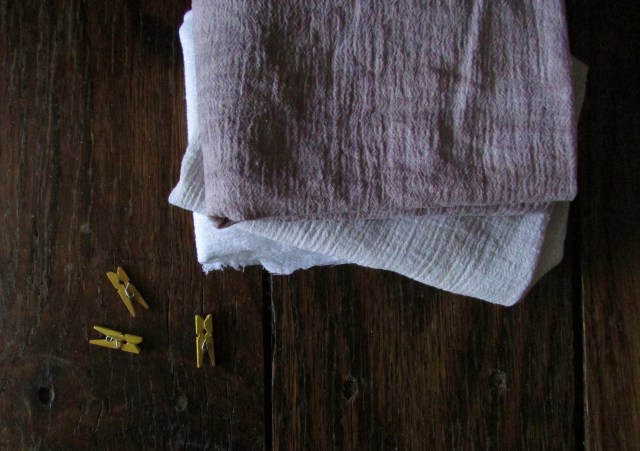I spend my work days discussing all facets of fabric including performance, construction, aesthetic, dye methods, etc., but rarely am I involved in the physical process of creating or dyeing fabric. A few weekends ago while on a walk around the preserve near our place, Ken and I came across a flourishing mulberry patch, and I got the idea to try my hand at fabric dyeing at home using our foraged mulberries. I didn’t know much about how to actually create the dyes using natural dye stuffs, so I called on the experience of Sweet Paul and Burda. The process is super simple, and the end result is beautiful!
I also experimented with shooting the fabrics in low light for moodier shots. My first foray, and I love how they turned out!
Materials Needed:
Prepare the Fabric for Dyeing:
- 100% cotton or linen fabric. I cut the into 24″ squares to use as tea towels.
- 1/2 cup Salt
- 8 additional cups of Water
For the Dye:
- 3 cups of Ripe mulberries or berries of your choice
- 8 cups of Water
- Large stock pot
- Fine mesh strainer
- Large bowl or small bucket
Other Materials:
- Drop cloth (optional)
- Clothesline and clothes pins for drying
Prepare the fabric by bringing 1/2 cup salt + 8 cups water to a boil in a large stock pot and simmering fabric for 1 hour. Remove from saltwater, rinse with cool water and ring out excess water. Discard salt water and rinse pot.
In the same stock pot bring 3 cups of berries and 8 cups of water to a boil on high heat. We used mulberries, but any berries can be used for different colors. Turn down heat slightly, use a spatula to smash the berries slightly to release more juice, and simmer for 15 minutes stirring occasionally. Drain the liquid through a strainer into a large bowl or small bucket, and discard of the berries.
Now its time to dye your fabric! Ah, so exciting. Lay down a drop cloth in your kitchen, or set up a dye station on your balcony (like I did) or outside. While the dye is still quite warm, place the fabric into the dye for either a few minutes or let it sit overnight, stir occasionally. The longer you let the fabric soak, the darker the color will be.
After dyeing, rinse the fabric with hot water and hang to dry. Don’t skip rinsing, or you’ll end up with dingy streaks on your fabric. Rinsing will remove some of the dye, so remove the fabric from the dye when it looks a bit darker than your desired tone.
The 3 colors shown are white (undyed), light warm grey (15 minute soak), grey plum (150 minute soak). The dye colors are very soft and almost “whisper” colors, which I think are beautiful!
Use the tea towels as is, or turn the raw edges under and hem. I always hand wash the dyed fabric, but it sounds like others have had success with machine washing, just make sure you do a separate load for any naturally dyed items, as the dyes will run slightly.
Notes:
- I ended up doing two rounds of dyeing, because I didn’t rinse the fabric the first time after dyeing. I wanted a darker color, and thought I’d see what would happen if I didn’t rinse. I learned the hard way, if you skip the rinsing step, you’ll end up with dirty looking fabric!
- Dyeing fabric with natural dye stuffs, i.e. berries, is a bit unpredictable in terms of the end color result. There doesn’t seem to be an exact recipe to achieve a particular shade of plum or blue, as there are tons of variables that can affect the outcome: the ripeness or potency of the berries, your fabric’s fiber content, etc. As you can see the lighter fabric took on a warm grey color, while the fabric that sat in the dye longer resulted in dusty plum, and others dyeing with mulberries have ended up with grey blue fabric?! It’s all about trial and error, so enjoy the ride!













Wanderluster
August 11, 2014 at 9:57 amThese fabrics are stunningly beautiful
Kate
August 11, 2014 at 10:55 amthis is cool! i hope you got to eat some of the mulberries too
i wrote on my blog several months ago about a couple of guys in town who do fermented plant dyes — no boiling, just long periods of soaking the plant matter (often for years) until the dye is done fermenting, then they dye the cloth. here’s the post: http://wildeconomies.wordpress.com/2014/01/21/slow-art-serge-piero/
they do really beautiful stuff, thought you’d appreciate it.
Bonnie Eng
August 11, 2014 at 3:01 pmWhat a neat idea! The color is so beautiful, I must try this sometime…thanks for sharing.
Joanne Chappellaz
August 11, 2014 at 8:59 pmSo beautiful! We have two mulberry trees in our yard but never thought much about them. Thanks for sharing this idea.